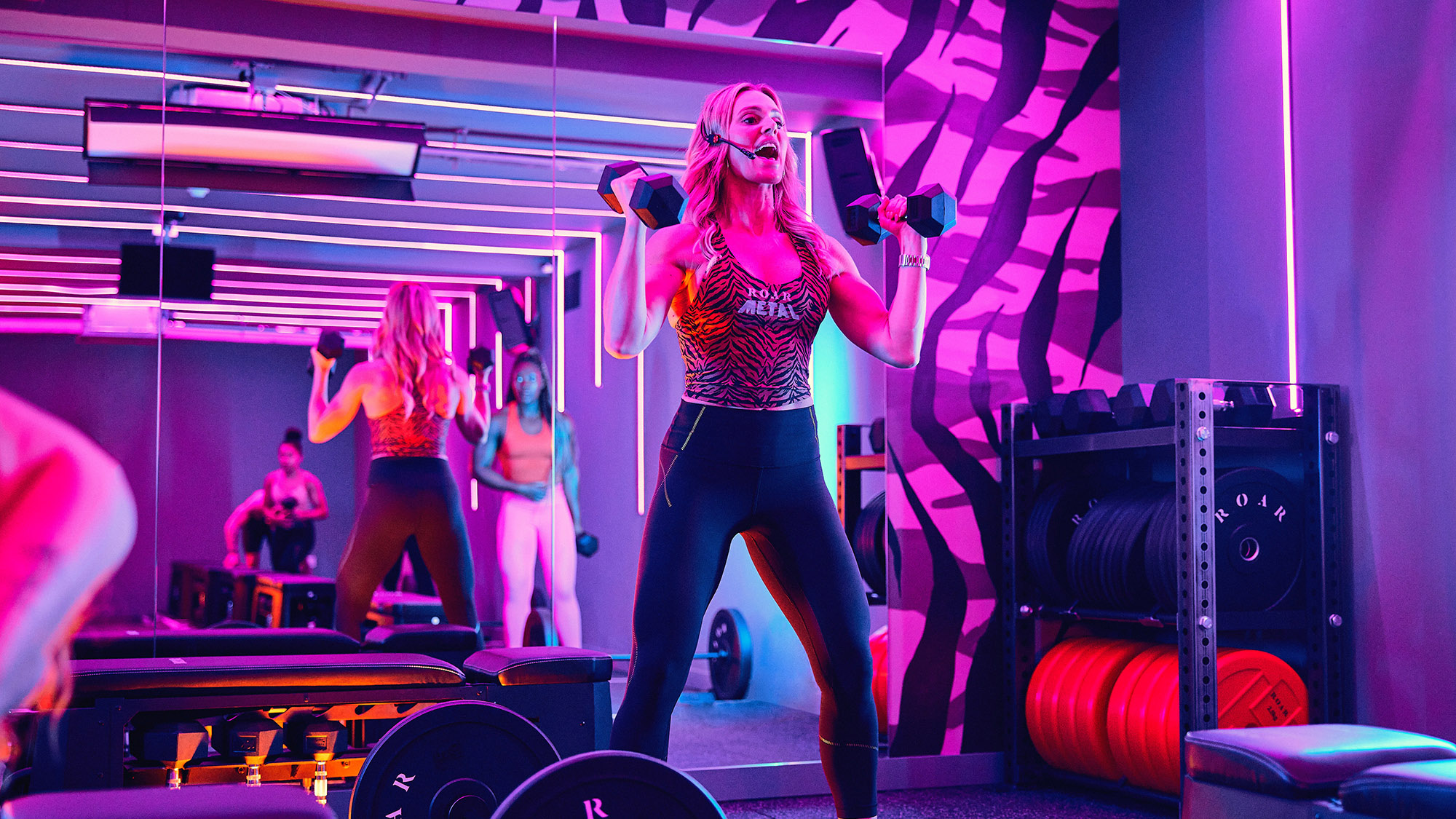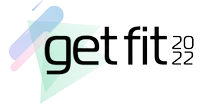Boutique gym owner shares her ultimate home workout for fat loss that uses dumbbells only
Triple Olympian Sarah Lindsay explains how to burn fat and lose weight with weight training at home



If you want to burn fat fast and shape up in record time, you need to step away from the treadmill and start lifting weights instead. Don’t believe us? Just ask three-time Olympic speed skater and leading body transformation expert Sarah Lindsey, a.k.a. the trainer of choice for celebrities including Vogue Williams, Nick Grimshaw, Piers Morgan, Professor Green, Ellie Goulding, Pixie Lott, Christine Lampard and Paloma Faith.
As the founder of Roar Fitness, Sarah is famed for helping her clients achieve jaw-dropping fat loss and muscle-building results - seriously, just take a look at her client transformations here - and the secret of her success lies in her full-body workouts that get the metabolism firing on all cylinders for show-stopping results.
Want to know more but can’t get to one of Sarah’s three London-based Roar Fitness gyms? Fear not! Here, Sarah explains all the reasons why you should give weight lifting a go, and reveals the ultimate weight lifting moves you can do at home or in the gym to hone and tone your body from top-to-toe. The best bit? You only need a pair of dumbbells to do them!
Don’t have any? Check out our round-up of the best dumbbells and best adjustable dumbbells to buy in 2022. Don't want to buy any weights? Try this 10-minute core workout from a top FightCamp coach or this 30-minute drill that's the best workout for weight loss at home instead!
How weight training helps with weight loss
According to Sarah, there are many physical gains to be had from training with heavy metal, such as increased bone density and improved athletic performance to injury prevention, less stress and a reduced risk of heart disease and diabetes - not to mention the scientifically proven fat-burning benefits! But why does weight lifting help with long-term weight loss? The answer lies in your metabolism.
‘When you focus on weight training, you will build muscle,’ explains Sarah. ‘And if you increase your muscle, you will increase your metabolism. Ultimately, the more muscle you have, the higher your metabolism will be, and that means you will burn more calories at rest long after you have completed your weight training workout. Effectively, weight training helps turn your body into a fat-burning machine.’
However, to get the maximum benefits from your resistance workouts, Sarah suggests you may need to rethink the way you currently work out.
Get all the latest news, reviews, deals and buying guides on gorgeous tech, home and active products from the T3 experts
‘Too many people do cardio first during their workouts, which then leaves them too tired to lift properly and unable to increase the intensity. But increasing intensity is the key to improving your metabolism for sustainable long-term fat loss and weight management (bodyweight exercises only work for so long because your body gets used to them quickly). Therefore, I suggest that you always weight train first during a workout. For me, cardio is the last piece of the puzzle.’

How to do Sarah Lindsay’s ultimate fat burning weight lifting workout
If you want to try weight lifting to burn fat and transform your body but have no idea how to get started, keep scrolling to see Sarah’s demonstrations of eight key resistance exercises that feature heavily in her Roar Fitness workouts.
‘If you master these exercises, you can use them as part of whatever programme goals you have because all body parts and movement patterns are covered,’ explains Sarah.
‘However, if you have no idea where to start, perform all eight exercises in a row as a circuit. Try doing 15-20 reps of each exercise with minimum rests in between the exercises, and then take a two-minute rest between circuits (after completing all eight exercises in a row). Do however many circuits you can in 20-minutes, and then slowly increase this duration to around 45-minutes as you get fitter and stronger.’
To do this workout, you will need a pair of dumbbells, kettlebells or the heaviest things around the house you can find.
‘As you get stronger, you will need to add more weight/resistance to your lifting to stimulate the muscle,’ adds Sarah. ‘The aim is to progressively lift heavier all the time and improve. Try and lift more weight every time you go to the gym or invest in heavier weights for the home. As you grow in strength and confidence, you can take all of these moves into the free weights section of the gym and start challenging what you can lift!’
Feel like you need more support or guidance on your technique? Try one of Sarah’s new 45-minute Roar Fitness group classes at Roar Fitness in Kensington, London (each class has a max of 10 people), or join in online from the comfort of your home with a daily timetable of live classes that are also available On Demand from £15 a month.
Best weight lifting workout for fat burn: the 8 resistance exercises to burn fat fast
1. Deadlift
In-depth: how to deadlift correctly
Why: ‘Working mostly the posterior chain (back, hamstrings and glutes), the deadlift is one of the exercises that have the most crossover into everyday life strength - think getting up and down and picking things up off the floor. Deadlifts will help strengthen your back and protect you from very common lower-back injuries.’
How: ‘Hold your weights in hands, with your feet shoulder-width apart. Keep your back flat and start the movement by pushing your bum back, hinging at the hips, and slowly sliding the weights down your thighs until the weight reaches your knees, then bend at the knees until the weight gets to your mid-shin. Return to standing straight using that exact movement pattern in reverse.’
2. Push-up
In-depth: how to do push-ups
Why: ‘For a more accurately measured progression of a chest exercise, you can perform a chest press or bench press if you are using a gym. In the meantime, a press-up is a tougher alternative, but it can be done at home without equipment. It's simply tougher because the starting weight (your bodyweight) is likely to be heavier than the dumbbells you would start with in the gym. A press up also requires more core which means we are hitting two birds with one stone.’
How: ‘Firstly, adopt that perfect high plank position with your body completely straight: the weight is on your toes and hands with the arms straight and just a little wider than shoulder-width apart. Holding your core tight, bend the elbows and slowly lower your body towards the floor. Go as low as you can without your chest or thighs touching down before you push back up. If you can't yet do a full press up, simply drop your knees to the floor, loading as much weight as you can through the upper body.’
3. Goblet squat
In-depth: how to do goblet squats
Why: ‘This exercise also offers a huge crossover into everyday life as we use this movement pattern every time we get up off the floor or out of a chair. If you don't maintain your strength through your full range as you get older, you may be able to get up off your seat, but getting up from the floor is a whole other ball game and this is where I see lots of people’s mobility - not to mention their confidence and independence - start to decline.’
How: ‘Stand with your feet hip-width apart and hold your dumbbell or kettle against your chest with your elbows up high. Keep the weight back into your heels and your back flat (spine neutral). Slowly bend the knees until your butt is as low as you can control without your body tipping too far forward or your heels lifting up. When you reach your end range, drive back up to the start position of standing.’
4. Bent over row
In-depth: how to do bent-over rows
Why: ‘One of my favourite “pull” exercises. Another big mover that works the upper back, posterior deltoids (shoulders), and biceps for great posture.’
How: ‘Holding your weights by your sides, keep your back flat and push your bum back behind you so that your torso is almost parallel with the floor (knees slightly soft but not bent). With your arms hanging straight down in the start position, draw both elbows back like you're trying to elbow someone behind you, squeezing your shoulder blades together at the top. Slowly lower the weights back down to start position.’
5. Shoulder press/overhead press
In-depth: how to do overhead press
Why: ‘These keep those shoulders strong and your frame athletic. You can do this one seated or standing. Personally, I prefer seated as it eliminates the urge to 'bounce' the legs a little and use momentum.’
How: ‘Sitting upright with or without back support (without just requires more core stability so the weight you will need will be less than with a back rest), start with your elbows out wide at right angles and the weights in line with your ears. Push the weights up above your head almost meeting in the middle but try not to clank the weights at the top as it takes tension off and is less controlled. Reverse this movement slowly back to start position.’
6. V-sit with a clap
Why: ‘One of my favourite core exercises. I also like to do v sits as a static hold (just holding your body in the ‘v’ position) but getting into position and finding your balance can be tricky.’
How: ‘To complete the move, lift your torso and one leg off the floor and give a clap underneath the elevated leg. The clap is not just for the fun but also a reference point so that you know you're lifting high enough. Don't worry if you feel like you're shaking – that’s just your transverse abdominals doing their thing which is good news!’
7. Split squat
In-depth: how to squat right
Why: ‘Keeping a unilateral/single-leg movement is really important for balanced muscle/strength development.’
How: ‘With one leg in front of the other with a bit of space between your legs (so you don’t feel like you’re balancing on a tightrope), hold the dumbbells relaxed by your sides. Slowly lunge your weight forward onto the front leg with a slight flexion (leaning forward) at the hip. Once you have reached your comfortable end range, keep the knee in line with the toe as you drive the weight back to start position.’
8. Dumbbell snatch
Why: ‘Now all the main moves are covered, I want to add some weighted movement to get your heart rate up, up, UP!’
How: ‘Stand with your feet shoulder-width apart holding a kettlebell or one dumbbell. Always keep your back flat and your spine neutral throughout this movement, especially as this is a faster, more dynamic exercise. Using that hip hinge, with your knees bent and your arms straight, push your bum back and guide the weight down between your legs, then as soon as the weight touches the floor quickly straighten the legs to drive the weight back up fast in one movement to up above your head.’
This feature is part of T3's Get Fit 2022 campaign. We’ll be bringing you a wealth of guides, features, deals and news to help you get healthy, fit and ready for anything the new year can throw at you. Whether you’re a newcomer to fitness or someone with a passion for it, we’ll bring you all the best workouts, diet advice and gear to set you on the right track.

Jo is a London-based freelance journalist and content creator specialising in fitness, health, lifestyle and beauty. With a degree in Journalism, Film & Broadcasting from Cardiff University and almost 20 years’ experience in the industry, she interviews celebrities and Olympians for a living, while testing out the latest beauty, hair, wellness and fitness gadgets. As a Level 3 Personal Trainer and author of several fitness guides, she gets to try the coolest workouts while reviewing active travel destinations and writing investigative features about the wonderful world of wellbeing for many of the UK’s top magazines, newspapers and digital publications. When she’s not sitting at her laptop, Jo likes exploring new walking spots with her beagle, gardening, and DIY. She is also one of the few people on the planet still obsessed with what’s coming up in Phase 5 of the Marvel Cinematic Universe.
